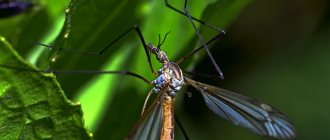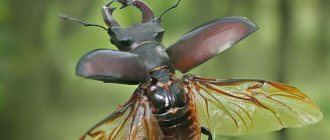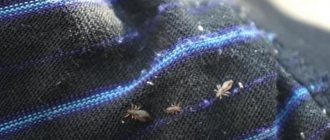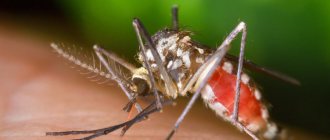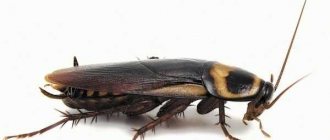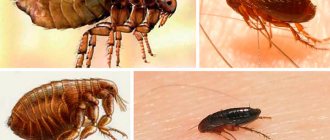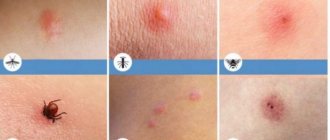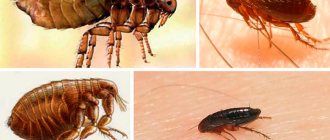People often ask questions: are large mosquitoes dangerous and who are they?
They can often be found near sources of water, as soon as you are near a river, lake or even the sea, where there is vegetation nearby.
Also, such mosquitoes choose “green” neighborhoods to live in, since in the area after rains, dampness lingers for a long time in the crowns of trees and tall grass. The situation can be aggravated by damp basements, which are so favored by mosquitoes. Basements are a favorite place where mosquitoes prefer to breed in the summer.
In a normal situation, an adult can easily survive mosquito bites, but the question is what to do for people prone to allergic reactions and children.
The most dangerous species is malaria mosquitoes, and you should certainly be wary of them. Although even ordinary small mosquitoes can significantly spoil both your health and your mood.
However, many are interested in the question of whether large mosquitoes, which can fly into the house in the summer, are dangerous.
Many, in panic, mistake them for malaria mosquitoes, others claim that although large individuals bite harder, they do not transmit the infection. There are adherents of the theory that large mosquitoes are males, which means they do not bite people, because even a child knows that only females suck blood.
What are large mosquitoes called?
There are more than 4,000 species of dipteran insects around the world. You can meet them in almost every corner of the Earth on all continents. In this article we will talk about one of the types of insects, which many people mistakenly confuse with blood-sucking pests. In Russia, a large mosquito is called a centipede or karamora. People call this insect a ballerina or a red mosquito. Some midge mosquitoes are reddish in color, but most are gray in color. In the photo you can see what a regular caramora looks like.
Characteristic features of a ballerina are elongated legs and long antennae. The size of the insect, as a rule, does not exceed 5-6 centimeters. However, in tropical latitudes there are caramors, the body size of which reaches up to 10 centimeters.
This “giant” is very difficult not to notice in the summer among the army of buzzing mosquitoes. In reality, centipedes do not pose a serious danger to humans. Karamora is most active at night. These harmless dipterans fly into the apartment, attracted by the light of a chandelier or table lamp. The centipede will fly around the room for a long time, bumping into furniture and sometimes the owners of the house.
Because of its long legs, it is difficult for the insect to move and escape from enemies. A ballerina can easily part with several long legs without harming her life. Thus, killing a large mosquito due to its inactivity during daylight hours will not be difficult.
Karamora lives in places with high and moderate humidity. The insect can be found in the forest, in the swamp, as well as in the valleys of rivers, streams and other bodies of water. Karamora avoids places with low humidity and temperature. It is impossible to meet a centipede in the Antarctic, Arctic or desert.
Kinds
The Karamore family includes more than 4 thousand species found on every continent on the planet. They like shaded, cool places near water, damp forest thickets, swamps, meadows, gardens, and greenhouses. Insects do not live only in a few regions of the Arctic and Antarctica, in areas with extremely low temperatures or arid climates.
The largest number (about 1,200 species) live in the Palearctic, a region that partially includes Europe, northern Africa, and Asia. 10 of them are considered terrible enemies of rural plantings, as they devour:
- Tender roots of garden crops;
- Young shoots of seedlings;
- Shrubs;
- Meadow plantings.
The most favorite delicacy for the Karamore are the larvae of blood-sucking individuals.
Swamp ballerina
One of the species of the largest mosquito in the world, living in the forests of European Russia, Ukraine, southwestern Siberia and Belarus. Some representatives are found in western Europe and the northeastern region of America.
Their diet includes:
- All grain crops;
- Perennial herbs;
- Hop;
- Vegetables.
They have a gray-brown tint. The distance between the tips of the wings is up to 4 cm. Adult representatives overwinter in the upper layers of the soil, and with the arrival of the first warm days they begin to feed on young, fragile shoots.
The larvae feel ideal at a temperature of 150 C and soil humidity of 50-60%. The pupa develops within 10-14 days.
Karamore autumn
It lives in the same places as the swamp, and almost throughout the entire territory of Russia to the southern regions of Sakhalin. The diet is similar to the previous type. The larvae begin to move after the upper layers of the soil warm up to 100 C. At first they feed on humus, but once formed, they attack surrounding plants.
The peak of gluttony occurs in June. At this time, annual crops already have time to get stronger. Insect pupae develop in about 20 days. It is believed that autumn caramores cause less harm than swamp ones.
Eastern centipede
Inhabits the entire territory of central and western Russia. The main damage is caused to rice plantations. Produces 2 generations of larvae: the first causes damage from early spring to July, the second - from mid-summer until frost and in early spring after hibernation.
Cabbage weed
Lives in European Russia and Ukraine. Its development is practically no different from the formation of the eastern species of Karamore.
Is a large mosquito dangerous to humans?
Many people mistakenly confuse the caramora with the malaria mosquito. However, the body sizes of these two insects are noticeably different: the malaria mosquito is much smaller. The thin body of the centipede is brownish-gray in color. The ballerina has the following features:
- big size. This species of mosquito is the largest in the world;
- the insect does not bite because it does not have the organs appropriate for this purpose;
- can harm plants;
- if necessary, it can throw away its paws. This autonomy allows the insects to evade the enemy.
Thus, we can say that caramora does not pose a serious danger to humans.
Appearance and dimensions
The main difference between the Karamore is the non-standard length of the legs. Thanks to her, the mosquito has another name - long-legged. The insect has an oblong head with 12-19 segments and large mesh eyes. His body is slender, his abdomen is elongated. Males are distinguished by a thickened tip of the body, females by an elongated one.
The forewings are translucent and narrow, and in certain species they are also variegated. The hind ones are presented in the form of short processes that play the role of a stabilizer during flight. The size of the largest mosquito can vary greatly: from 2 mm to 6 cm. Individual representatives reach 10 cm in length.
You need to understand that the mosquito owes its dimensions to the length of its legs, since its body is quite small. If the insect is in danger, then when it takes off, it leaves one limb in the attacker’s mouth. Scientists call this event autotomy, that is, self-mutilation.
How long do they live?
The period of Karamora activity begins in the second half of July and reaches its peak in the last month of summer. The insect lays eggs in moist soil: peat bogs, muddy banks, and so on. In such maximum comfortable conditions, the development time of future ballerinas takes about 12-15 days.
In moist soil, caramora eggs go through several stages of development. If the thermometer does not exceed 15 degrees Celsius, the future centipedes pupate and only two weeks later adults are born. If the female laid eggs later in the fall, they stop developing and sleep all winter, waiting for more favorable conditions. This period can be up to 11 months.
In comfortable conditions with moderate humidity, the caramora manages to reproduce no more than one generation of insects per year.
Lifespan
The lifespan of the world's largest mosquito is short. The female lives a maximum of 2 months, the male - a little less. Females born at the end of August do not breed offspring, but accumulate strength for a good winter.
After a cold snap, they squeeze into cracks and freeze until spring. Having woken up, they immediately begin to lay eggs in the nearest body of water. Among the Karamore there is no spring marriage ceremony.
Like other insects, large mosquitoes have their own natural weight. Their reproduction and growth is an important link in the food chain of all earthly inhabitants. They provide significant benefits in aquarium keeping. Karamore are further proof that any living creature should be judged by real facts, and not by appearance.
What do big mosquitoes eat?
Female centipedes, like males, feed exclusively on plant nectar and the juices of rotting fruits and vegetables, or do not feed at all. The caramora receives all the nutrients necessary for life in the larval stage.
Karamor larvae cannot be called as harmless. They can cause significant damage to agricultural crops. Delicacies include rice, corn and sunflowers. After birth, ballerina larvae feed on humus or algae if they fall into the water. Large mosquitoes eat the larvae of blood-sucking representatives of their order.
Stages of development
The female of the largest mosquito in the world lays glossy black elongated or round eggs covered with a dense, opaque shell. She does this in water: a lake, a pond, an ordinary puddle. Eggs can be left to “ripen” in rotting wood or in damp moss.
After about a week, the larvae hatch from them and begin to feed on the surrounding organic matter. They live in a damp environment:
- Decaying trees;
- Soil;
- Forest turf;
- Unsalted reservoirs.
They have a well-developed, large head with impressive jaws, allowing them to consume plant remains and gnaw on living rhizomes.
Having emerged from the eggs, the larvae try to hide. To do this, they turn over, clinging to the water film with their tiny tails. In case of danger, they dive to the bottom, where they mature, feeding on algae.
After pupation, they take on a loose cylindrical shape. The covers of their legs are well drawn to the body, parts of the abdomen are decorated with spines arranged in a transverse order. With the help of the latter, the pupae easily slip out of soft earth or wood dust.
Do they bite or not?
The most important questions that haunt many adults and children: do large mosquitoes bite people and what will happen if a large mosquito bites? The fear of this insect is completely justified; seeing a mosquito of such impressive size is difficult to remain calm. However, there is no need to worry, the ballerina does not have piercing bristles, which can be used to pierce the skin. Therefore, the centipede simply physically cannot drink human blood.
The caramora can feed on the nectar of plants thanks to its long proboscis. There are a sufficient number of insects that have absolutely no need for a food source. After emerging from the chrysalis state, the ballerina's main task is to reproduce and lay eggs.
Is blood included in the centipede's diet?
For many people, the sight of a large mosquito with long legs causes panic. After all, people don’t know how dangerous the large centipede mosquito is. To understand this, it is necessary to study their taste preferences and structural features. Although these insects have a long proboscis, they are not dangerous to humans. After all, they receive nutrients not from blood, but from plant sap. To obtain nectar, the largest mosquitoes destroy the integrity of the root system, plant stems or algae.
Are they dangerous for humans?
Despite the fact that the caramora is completely indifferent to blood, the insect poses a serious problem for agricultural land. The following representatives of the order Diptera insects can cause the greatest harm:
- Marsh Centipede;
- Cabbage caramora;
- Autumn ballerina.
These pests have a detrimental effect on plant crops that love moisture. Caramora larvae can destroy a significant part of the crop sown on wet mineral soil and peat bogs. Ballerina can harm berries, legumes, root crops and cereals. Cultivated pastures located near water are most susceptible to mass attack by caramora larvae.
In the summer, centipede larvae are fought, like all pests, with the help of modern insecticidal agents and fall plowing is done. In summer cottages, the same methods are used to combat ballerina. However, if there is no body of water near your site, there is nothing to worry about; the larvae will not be able to damage the crop.
Now you know how dangerous large mosquitoes are.
What signs does a mosquito use to find its victim?
Bloodsuckers have extensive sensory capabilities. They rely on touch, smell and vision. First things first:
- The antennae are highly sensitive. They pick up the slightest unnatural vibrations in the air. These antennas replace ears, full hearing.
- Mosquitoes have a very strong sense of smell. They fly towards carbon dioxide and lactic acid smells. Research also shows that they are attracted to other smells. For example, some alcoholic drinks.
- Vision has a specific structure. Bloodsuckers see in the ultraviolet spectrum, just like people. But the ability to see is seriously different from the human one. For example, these creatures are very nearsighted. They focus on colors and quick movements. They also have the ability to see in the infrared, thermal range. A person with his typical temperature in the darkness of the night looks like a bright lantern that attracts uninvited guests.
According to various estimates, a female can fly up to 5 kilometers in search of the necessary food. And this does not take into account wind currents, which help it cover even greater distances. Uninvited guests find people at a distance of up to 15 meters, without any problems catching all the mentioned signs right in flight.
Interesting: What diseases do mosquitoes carry?
Centipede mosquito: benefits and harms
The most important questions for humanity are whether the Karamora mosquito is dangerous, whether it drinks blood, and whether large mosquitoes bite. Many people mistakenly call it malarial and are terribly afraid. The grass mosquito prefers flower nectar and helps bees pollinate plants. Unlike other species, it does not pose any danger to humans, since it is anatomically incapable of biting through the skin. The statement that it was bitten by a large mosquito is incorrect. The only thing a caramora is capable of is to scare with its appearance.
However, a huge mosquito often turns into a garden pest, causing a lot of trouble and reducing productivity. Fruit mosquito larvae damage berries, apples, plums, cherries, pears, apricots and many other garden crops.
For the garden, the greatest danger is posed by the swamp red mosquito, cabbage mosquito, and autumn mosquito. Before pupation, the larvae begin to feed intensively, replenishing their reserves for the winter. Root crops, cereals, legumes, and tubers are damaged. An insect similar to a large mosquito can destroy rice crops in a season.
Interesting representatives
In nature, there are more than 4 thousand varieties of this family, some of them have such an attractive appearance that they are admired like butterflies.
The festive centipede or decorated ctenophora leaves no one indifferent and does not cause fear. The name speaks for itself. The photo is shown below.
Festive centipede
It lives in our area and is included in the Red Book of Russia and Ukraine. Body length reaches 26 mm. He practically cannot fly, although his wings are quite large. It also bites, feeds on the juices of plants, fruits, and nectar. The larvae are pests and damage deciduous trees.
Amazing color with black, yellow, orange, brown. The abdomen is striped, slightly reminiscent of a wasp. The same long limbs, but colored black and orange. Males have lemon-colored antennae. Insect larvae develop in rotten wood and old hollows. The reason for the extinction of the species is intensive deforestation of broad-leaved forests.
